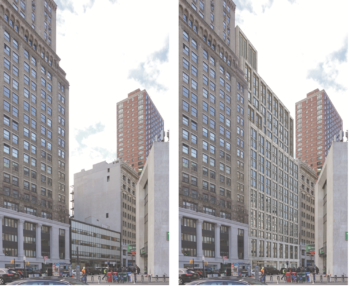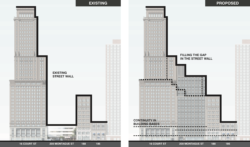
Existing building at 200 Montague Street in Brooklyn (left), and proposed new building (right). Image Credit: Beyer Blinder Belle/LPC.
Landmarks Commissioners disagree over the proposed demolition of the existing building and design of the new building. On March 5, 2019, the Landmarks Preservation Commission held a public hearing on a Certificate of Appropriateness to demolish an existing 1960s altered Modern style commercial four-story building and construct a new 20-story building at 200 Montague Street within the Borough Hall Skyscraper Historic District in Brooklyn. The application was presented by Richard Metsky of Beyer Blinder Belle.
The Borough Hall Skyscraper Historic District is comprised of 21 buildings, a majority of which were constructed between 1900 and 1930s. The applicant’s existing altered Modern style four-story building at 200 Montague Street was designed by Philip Birnbaum and initially built to two-stories in 1959-1960 before two additional stories were added in 1967-68. The building was used as a bank and had a drive-through until the 1990s, when the drive- through was taken out and replaced by storefronts. In 2005, the building’s existing curtainwall collapsed, requiring significant alterations.
The applicant proposes to demolish the existing building, and to construct a new 20-story building that will have retail on the first floor and residential units above. The new building will be set back seven feet from the street until the 15thfloor, when it will be set back again an additional eight feet before it gets to its total height of 215 feet. The applicant’s intent is to infill the existing gap between the taller 16 Court Street building to the left of the site, and shorter 188 Montague Street to the right of the site in order to create a continuity of streetwall.

Streetwall comparison with existing building (left) and proposed building (right). Image Credit: Bayer Blinder Belle/LPC.
The design of the building is intended to resonate with other buildings within the Borough Hall Skyscraper District, with inspiration drawn from the rhythm of structural bays, clustering of windows and sculptural elements, the monochromatic tonality, and ornamental profile piers seen on other buildings within and immediately surrounding the historic district.
The new building would be constructed with a granite base, limestone on the first to third floors, and glass fiber reinforced concrete on the fourth to the twentieth floors. The window mullions would be of gray painted aluminum except for the transition floors where the windows would be of bronze painted aluminum for contrast.
Four speakers testified in opposition to the application, including John Arbuckle of DOCOMOMO New York, Judy Stanton of the Brooklyn Heights Association, Christabel Gough of the Society for the Architecture of the City, and Jesse Denno of the Historic Districts Council. The speakers both defended the significance of the existing building and its contribution to the historic district, and opposed the new building’s design. Some of the speakers called for either a restoration of the original building, or a new design that echoes the original style.

200 Montague Street before 2005 alterations (left), and after (right). Image Credit: Bayer Blinder Belle/LPC.
Landmarks Preservation Commissioners struggled to reach a consensus on demolition. Some viewed the building as no longer a true reflection of Birnbaum given the 2005 alterations and therefore were supportive of the demolition. Others felt that despite the 2005 alterations, the building is an important representation of 1960s design and architectural evolution of the street and the area from a commercial perspective.
The Commissioners generally agreed that the proposed building was not robust nor distinct enough for a historic district comprised of 21 unique and stand-alone structures. Some Commissioners suggested that homage should be paid to the existing building, respecting its history in contributing to the streetscape in a unique way. Several Commissioners pointed to the existing building’s scale and size as providing a dramatic contrast with the other buildings, which also makes it unique. Commissioners stated that the new building should be a centered object and seen as an individual, and not as an addition to the existing buildings.
The hearing was closed with the Commission recommending that the applicants return with revised plans based on the Commission’s input.
By: Viktoriya Gray (Viktoriya is the CityLaw Fellow and New York Law School Graduate, Class of 2018).

